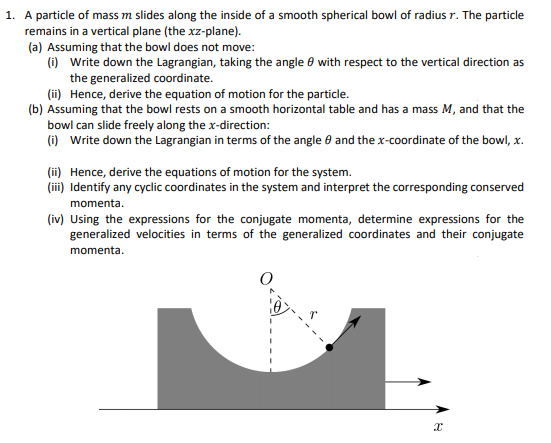Good day, I obtained T as 1/2m(r \theta\dot)^2 and V as -mgrcos\theta. If something else is obtained could you explain it as well for my understanding. Kind regards.
Good day, I obtained T as 1/2m(r \theta\dot)^2 and V as -mgrcos\theta. If something else is obtained could you explain it as well for my understanding. Kind regards.
Related questions
Question
100%
Good day,
I obtained T as 1/2m(r \theta\dot)^2 and V as -mgrcos\theta.
If something else is obtained could you explain it as well for my understanding.
Kind regards.

Transcribed Image Text:1. A particle of mass m slides along the inside of a smooth spherical bowl of radius r. The particle
remains in a vertical plane (the xz-plane).
(a) Assuming that the bowl does not move:
(i) Write down the Lagrangian, taking the angle 8 with respect to the vertical direction as
the generalized coordinate.
(ii) Hence, derive the equation of motion for the particle.
(b) Assuming that the bowl rests on a smooth horizontal table and has a mass M, and that the
bowl can slide freely along the x-direction:
(i) Write down the Lagrangian in terms of the angle 0 and the x-coordinate of the bowl, x.
(ii) Hence, derive the equations of motion for the system.
(ii) Identify any cyclic coordinates in the system and interpret the corresponding conserved
momenta.
(iv) Using the expressions for the conjugate momenta, determine expressions for the
generalized velocities in terms of the generalized coordinates and their conjugate
momenta.
Expert Solution
This question has been solved!
Explore an expertly crafted, step-by-step solution for a thorough understanding of key concepts.
Step by step
Solved in 2 steps with 2 images
